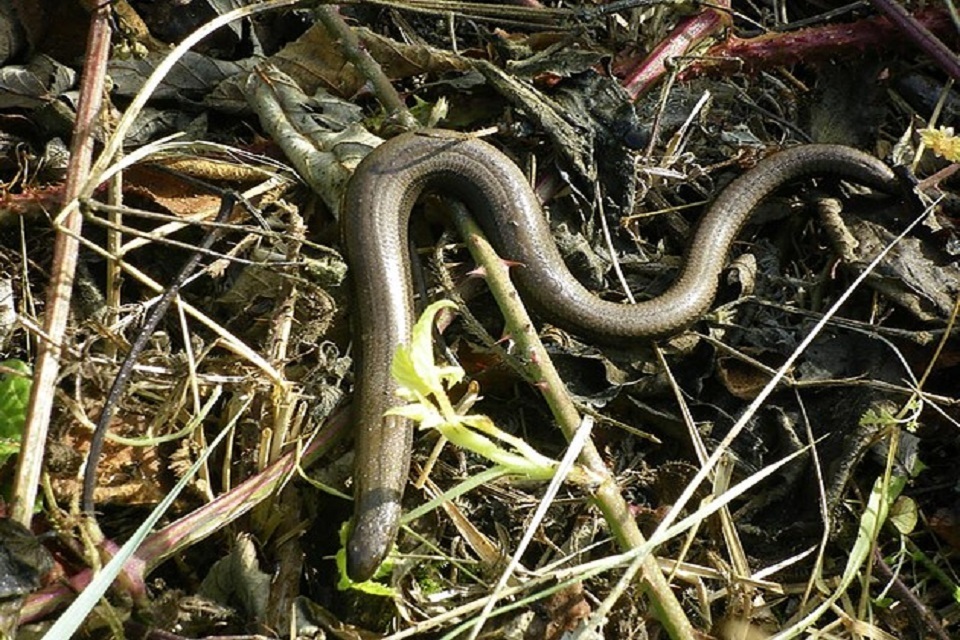Shoreham Adur tidal walls scheme: ecology
Published 10 November 2017
Reptiles
Reptile species, such as common lizards, slow worms and grass snakes, have been moved from the work area. Over 500 animals were found at these sites and they have been moved to specially created receptor sites.
To provide suitable habitat, dense brambles were cleared and grass was moved onto the bare ground. Hibernation features were also built on this area using logs. This area is fenced off at the moment to keep the reptiles safe. Once the works are finished the fences will be removed and the population will naturally re-colonise the new flood embankment.
After the move was complete, the vegetation along these areas were disturbed under the supervision of a trained ecologist using an excavator. This helped the Environment Agency to capture any remaining reptiles whilst also making the habitat unsuitable for them to move back in.

Slow worm
Birds
There is a large bird population in Shoreham. As nesting birds are legally protected, the Environment Agency has removed any potential habitat outside the nesting season.
This doesn’t just include the trees and bushes where you would expect birds to nest. A long-term swan’s nest on the mudflats, behind Riverside Road, was monitored to make sure it was not active before it was carefully dismantled and removed.
The Environment Agency has also found another unusual nesting site in piles of timber and wood on the bank behind the house boats. Small birds such as wrens are likely to nest in the undisturbed cavities within the wood. As these habitats are located along the line of the new sheet pile wall, staff have carefully removed the timber by hand in spring as part of reptile mitigation.
Plants
Shoreham is home to some rare plants, which may be impacted by the scheme. The first is Childing Pink, a native annual plant which grows on thinly vegetated stable shingle. It is very rare nationally and only known at two sites in Sussex (Shoreham-by-Sea and Pagham Harbour). At Shoreham, the main colony is protected within a local nature reserve, which will not be affected by the scheme. Where the plants have spread beyond the reserve, some areas will be disturbed by construction. As the plants are annual, the Environment Agency can move the shingle containing Childing Pink seed and place it on suitable ground where the plants will be able to germinate.
Representatives from the project team have met with the Friends of Shoreham Beach to discuss the mitigation. The Environment Agency will remove the dense vegetation within the nature reserve which has suppressed the growth of the plant and create the bare shingle onto which seed containing material can be re-located. This should give the flower space to further thrive once contractors have left site.
The second plant is Starry Clover, which is only known in Britain at Shoreham, where it was first discovered in 1804. The red coloured sepals (protective outer parts of the flower) give it its name.
It occurs on various banks around Shoreham Fort, although being an annual, its location can vary from year to year. The areas it occurs in will be fenced off outside the works area, so it can be protected.
Protection of the wider landscape
The project is not only protecting wildlife but also the wider landscape. Trees are an important part of the local landscape. Once the design was finalised, an arboricultural (tree) survey was carried out to assess which trees could be retained and which had to be removed. Those to be kept will be protected from the works so they are not damaged.
Where possible, the design has been altered to reduce the amount of tree loss. A good example is the small copse between the tidal lagoon and the recreation ground. By altering the line of the original bund the Environment Agency can avoid cutting the corner of this habitat and work around it instead. This means that the Environment Agency will no longer need to remove those trees.
Landscape plans have been drawn up by the designers to show how the local environment will be replaced. For example, double the number of trees and shrubs will be planted compared to the number removed. Where possible and appropriate, native locally sourced species will be replanted.
As part of the design, an area of saltmarsh habitat will be created next to the airfield. The new bund will be built closer to the airport road and the old embankment will be removed. The ground beneath the old bund will be levelled to create conditions that will allow the existing saltmarsh vegetation to naturally colonise. This small scale ‘managed retreat’ will compensate for the loss of salt marsh elsewhere on the scheme and will increase the area of this important habitat, which is why the Adur Estuary has been designated a Site of Special Scientific Interest (SSSI).
Archaeology
Shoreham has many archaeological and heritage features including Shoreham Fort Scheduled Ancient Monument (SAM), and World War 2 pillboxes around Shoreham Airport. The Environment Agency will be taking steps to protect the heritage throughout construction.
The Environment Agency has found approximately 7 new (not previously known or studied) World War 2 structures within the Shoreham Airport reach. These include a previously unidentified pillbox and anti-aircraft gun emplacement at the north of the site.

